Concepts
How Google’s crawlers, Uber’s drivers and Instagram’s selfies power the platform economy
This article is #4 in an ongoing series on the design of platform business models.
What do Google’s crawlers, Uber’s drivers, and Instagram’s selfie-clickers have in common? Or for that matter Elance’s freelancers, Dribbble’s designers, and Twitter’s tweeters. In a world of platforms, they create the fuel needed to facilitate economic and social exchanges that power business and society.
More on this in a moment! Let’s set some context first!
There are two defining characteristics of today’s economy: it’s networked and it’s built around information. YouTube’s open-access network allows anyone to create videos but it is the information/data in the video that determines who it is served to for consumption.
We noted in the last article how the movement of goods and services as well as of money is increasingly being determined by the movement of information. Today’s digital platforms enable the exchange of information to power the exchange of goods, services, money, reputation and attention; essentially all social and economic exchanges.
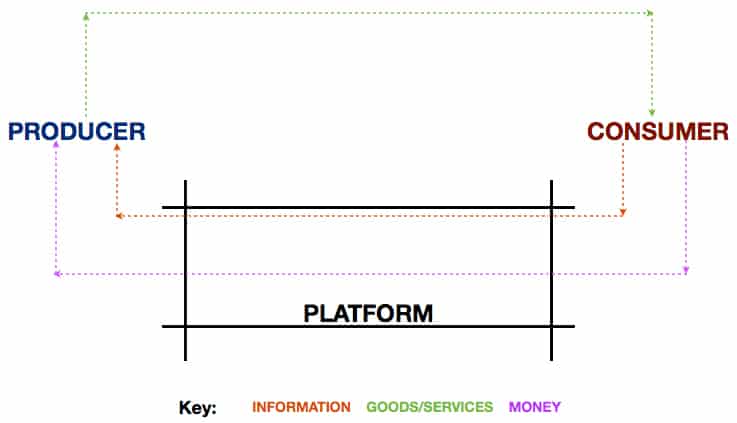
Uber’s drivers, for example, announce their availability and coordinates on the platform by sharing various parameters on location, availability etc. Drivers create value units: information about themselves that helps them to be matched to the right consumer. When a consumer pulls out his phone and requests for a cab, he creates a filter i.e. his location. The driver that is most relevant to a consumer’s location and time of request is sent across.
Once this match is made, everything else clicks into action. The taxi turns up; the traveler is taken to his destination, the appropriate charge is transferred out of the traveler’s account, and the taxi driver is compensated.
All subsequent exchanges occur once the information exchange takes place.
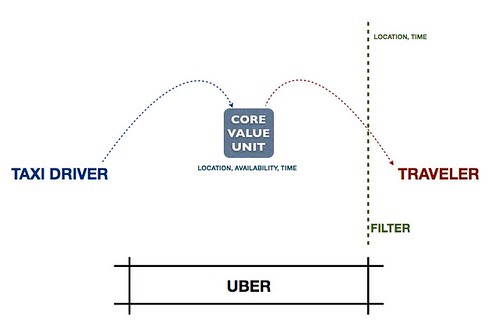
The information exchange has three key components:
- The producer (taxi driver) creates a core value unit (information about availability, location, etc.)
- The consumer (traveler) sets up a filter
- The unit(s) that pass through the filter are notified, and one of them fulfills the need
(Some parts of the above interaction are simplified to illustrate the commonalities across platform businesses.)
CORE VALUE UNITS AND FILTERS
This is a recurring pattern that we see across information businesses, in general, and platforms, in particular. Units are produced and served to consumers based on how they pass through certain filters.
Even if you haven’t used Uber’s taxi booking platform, you’ve probably used Google’s search engine at some point. Google’s search engine acts in a very similar way.
Google’s crawlers crawl the web and create web page indices (value units). Users type in a query which acts as a filter. Units are passed through this filter and served on the basis of relevance to the filter. (Google’s algorithm includes more inputs into the filter including social signals but this serves to illustrate how units and filters work together.)
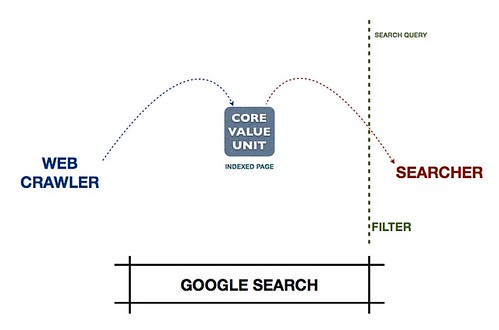
Instagram-wielding teens click selfies all day and create core value units on the platform. These units are then served to other users based on network connections (filter) with the creators.
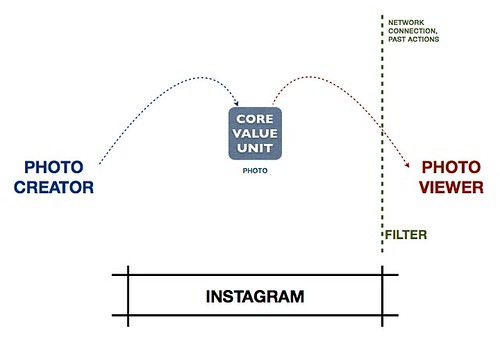
Facebook’s news feed makes this dynamic clearer. Your entire network creates status updates, pictures, comments, etc., all units added to the platform. Your news feed algorithm, then, acts as the filter that determines which units go through and are shown to you and which ones are not. This filter is built based on signals you’ve given in the past through your interactions with the news feed content.
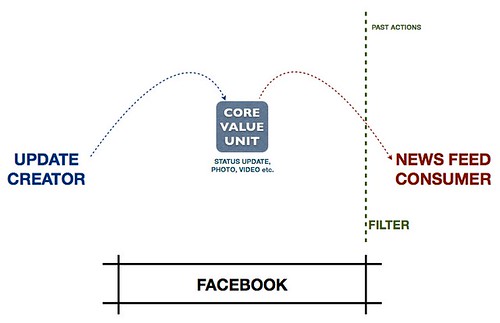
CORE VALUE UNIT: THE FUEL THAT RUNS THE PLATFORM ECONOMY
Platform businesses are useless without value units. One look at an empty search results page will rapidly prove that.
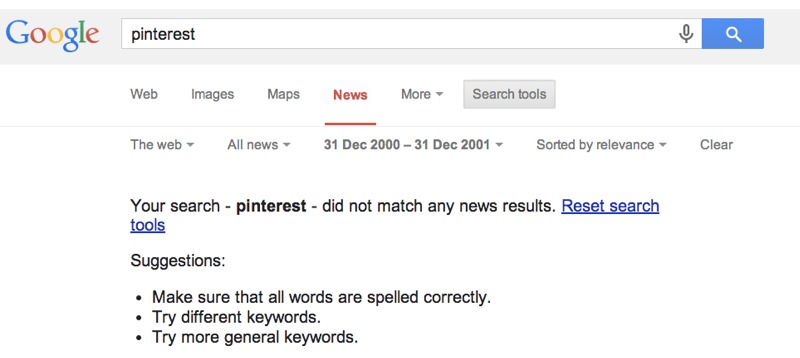
The core value unit is the fuel that powers the platform. At any given point, a platform is only as useful as its ability to match it’s units to the filters that consumers have.
The value proposition of a platform revolves entirely around its core value units.
From a producer’s perspective, a platform is:
- An infrastructure to create or store units. Android provides an infrastructure for the creation of applications. YouTube provides an infrastructure to host videos.
- A marketplace to find an audience for the goods/services represented by the units. Airbnb acts as a marketplace for listings that represent rooms; Uber serves as a marketplace for information that represents available taxis.
From a consumer’s perspective, a platform is:
1. A repository of units where the consumer can discover units based on her filter.
The value proposition revolves entirely around the value units. A platform without units has little or no value proposition. A platform that fails as an infrastructure or a market for value units will not attract producers. A platform that fails to match the right units to consumers will fail to hold on to them.
THE UNIQUE CHALLENGE OF PLATFORM BUSINESSES
You may have figured by now, especially given the Google crawler illustration, that the concept of the core value unit is central to all information businesses. Even when information businesses behave like pipes, they transfer value units from the point of production to the point of consumption.
But value units are especially interesting in the case of platforms. Unlike pipes, platforms don’t control quality and quantity of their core value units. Platforms are information factories without control over inventory. They can create the factory floor i.e. provide the infrastructure. They can create a culture of quality control. But they do not have an iron hand in controlling the quantity and quality of what is produced and consumed. The challenge of building and managing platforms is that you do not exert direct control over your value proposition.
As a result, a focus on the core value unit is doubly important if you’re running a platform. Deciding who can create such units, how they are created, what differentiates a high-quality unit from a low-quality one are all critical design decisions while building a platform. We’ll explore these further in subsequent essays.
DISTRIBUTED PRODUCTION IN AN AGE OF PLATFORMS
The age of the industrial economy accorded inordinate power to those who held the means of production. In the age of platforms, production is distributed. Whether it is the distribution of manufacturing through 3D printing, the distribution of marketing and journalism through social media or the distribution of service providers in the collaborative economy, the means of production are no longer limited to a large company or entity.
With distributed production, the platforms that enable and aggregate this production are the new winners. Successful platforms create the right tools, incentives, and rules of participation to attract producers who create units reliably and regularly.
Further, in a platformed world, the people and processes that determine quality and quantity of units are the keys to success. Google’s ability to serve results and solve the world’s problems collapses if its crawlers don’t work well. Uber’s ability to serve consumers collapses if there aren’t enough drivers available within a particular area. Instagram’s ability to engage users in conversations and keep them away from competition collapses if teeny boppers stop taking selfies every time they visit the bathroom.
But…
A Platform’s work doesn’t stop with the production of Value Units.
Successful platforms need these value units to pass through filters as well. This is where data becomes important.
Google's crawlers, Uber's Drivers, and Instagram's selfie-clickers are the new producers in the Platform Economy
Feel Free to Share
Download
Download Our Insights Pack!
- Get more insights into how companies apply platform strategies
- Get early access to implementation criteria
- Get the latest on macro trends and practical frameworks
BIG OR SMALL, IT’S ALL ABOUT DATA!
There is a lot of hoopla around the ‘big-ness’ of data. But big or small, an understanding of Value Units and Filters helps us understand the role of data in today’s economy.
Value Units pass through Filters because of data.
Consider how a YouTube video is served to you.
The video (Core Value Unit) has various forms of data associated that include information on WHAT it is (title, description), HOW GOOD it is (votes etc.) and WHO it can be served to (explicit content etc.).
The video is served in various ways.
- It may show up on your news feed. The news feed acts as a filter which takes into account data on WHAT you have consumed in the past.
- It may show up in response to a search query. The search query contains the data that serves as the Filter. You could then slice and dice through your search results further by adding parameters to the Filter (video length etc.)
- It may be shown as a related video at the end of a video that you consume. In this case, the similarity to the current video, as well as your past consumption behavior, work together to create the Filter.
In all these cases, the Core Value Unit has data, and the Filter has data. Units pass through Filters when the data of the two match with each other.
FILTERS: PUSH AND PULL
So how do filters work?
Filters, essentially, are data about what the consumer finds relevant. For a location-based application, the location is a filter. For search engines, search queries act as filters. The News Feed creates a filter based on past actions and signals. The Twitter feed’s filter relies almost exclusively on recency.
Filters can pull Units to themselves. That’s what search queries do.
Units can also be pushed through Filters. That’s how the news feed works.
JP Rangaswami recently wrote a great series on Filters that I’d highly recommend.
RUNNING THE PLATFORM ENGINE
In steady state, a platform is an engine that works on the following heuristic:
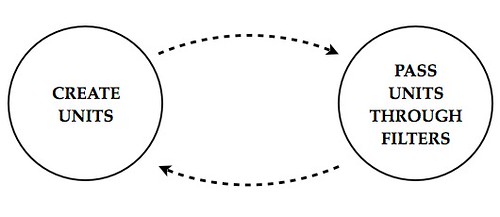
Three things are required to make this happen:
- Value Units need to be created
- Filters need to work well
- The platform needs good data about units as well as filters to ensure the right units pass through the right filters.
In the next essay, we’ll look at how platforms enable this engine.
TWEETABLE TAKEAWAYS
The new economy runs on data. Data matches value units with filters. Tweet
The Platform Economy runs on Distributed Production and Personalized Filtering. Tweet
To read the rest of the posts in this series, click here.
State of the Platform Revolution
The State of the Platform Revolution report covers the key themes in the platform economy in the aftermath of the Covid-19 pandemic.
This annual report, based on Sangeet’s international best-selling book Platform Revolution, highlights the key themes shaping the future of value creation and power structures in the platform economy.
Themes covered in this report have been presented at multiple Fortune 500 board meetings, C-level conclaves, international summits, and policy roundtables.
Subscribe to Our Newsletter













